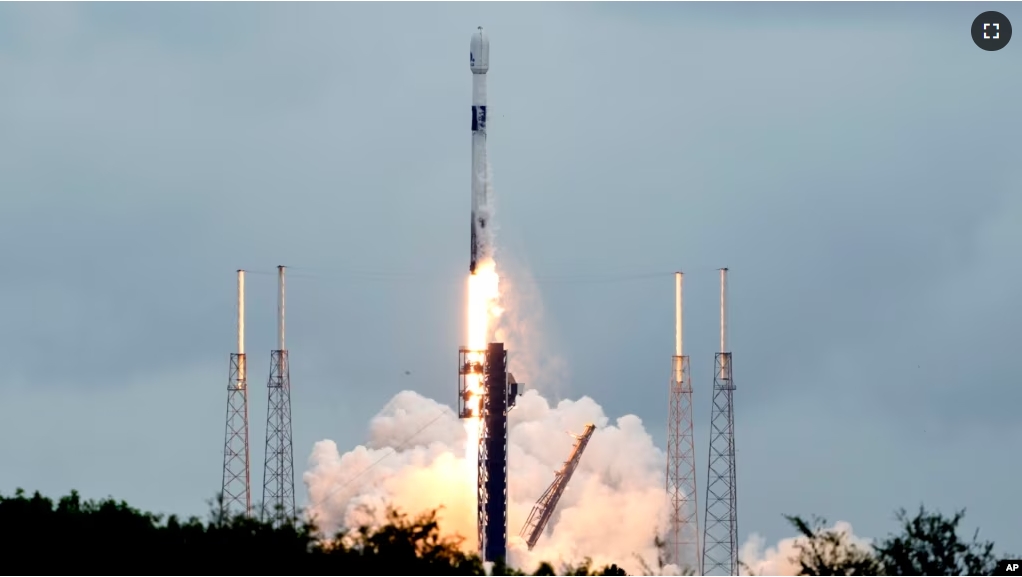A European spacecraft has been launched to explore an asteroid struck in an earlier planetary defense mission by the American space agency NASA.
The European Space Agency (ESA’s) Hera spacecraft launched October 7 from NASA’s Cape Canaveral in Florida. The spacecraft, or probe, was carried to space aboard a SpaceX Falcon 9 rocket.
Hera is headed to the asteroid Dimorphos. NASA crashed its DART spacecraft into the space rock in 2022 in an area about 11 million kilometers from Earth. The NASA mission was an experiment to test a method for changing the orbit of asteroids that might one day threaten Earth.
NASA has said its own studies of the crash showed it was successful because the force of the strike changed the asteroid’s orbit around a larger asteroid, called Didymos. Data showed the strike reduced the orbital period of Dimorphos by 33 minutes.

But the Hera mission seeks to closely examine Dimorphos to get more details on how the asteroid was changed in the strike by DART. Data collected by the ESA spacecraft will be used together with information gathered by NASA to develop future planetary defense plans.
American astronomer Derek Richardson, from the University of Maryland, told reporters before the launch, “The more detail we can glean the better as it may be important for planning a future deflection mission should one be needed.”
Officials from ESA have described the $400 million mission as a “crash scene investigation.” Hera project manager Ian Carnelli said the spacecraft was “going back to the crime site and getting all the scientific and technical information.”
Hera’s trip to the asteroid is expected to take about two years. Next year, the probe plans to get a big gravitational push as it flies past Mars. It should arrive in the area around Dimorphos in December 2026.
Before it was hit by DART, Dimorphos circled a larger asteroid from about 1,189 meters out. Scientists believe the orbit is now closer and that Dimorphos changed its shape. Astronomers have also found evidence the asteroid is likely moving differently.
Examinations of the DART mission have suggested that rather than being a single hard rock, Dimorphos was more of a collection of rubble pieces held together by gravity. Investigators have said they believe the DART crash might have “completely deformed” the asteroid.
Ignacio Tanco is the flight director for the Hera mission. He told The Associated Press that some large rocks and other materials could still be following the asteroid. This, he said, could present a damage risk to the spacecraft.
“We don’t really know very well the environment in which we are going to operate,” Tanco said. “But that’s the whole point of the mission is to go there and find out.”
Hera will be equipped with two nanosatellites. One will land on Dimorphos and capture data on the asteroid with radar. The other will study the makeup of Dimorphos from farther out.
ESA and NASA will use the data to create plans for a possible asteroid strike that could cause wide destruction on Earth. Astronomers believe an asteroid wider than one kilometer – which could cause a worldwide disaster – is estimated to strike Earth about every 500,000 years.
An asteroid around 140 meters – which is a little smaller than Dimorphos but could still take out a major city – is predicted to hit Earth around every 20,000 years.
Currently there are no known 140-meter asteroids on a path to strike Earth. However, scientists have said only 40 percent of those space rocks are believed to have been identified.
I’m Bryan Lynn.
Bryan Lynn wrote this story for VOA Learning English, based on reports from
Quiz – Europe Launches Spacecraft to Explore Asteroid Hit by NASA

Start the Quiz to find out
___________________________________________
Words in This Story
asteroid – n. a rocky object that goes around the sun like a planet
glean – v. to discover something slowly or with difficulty
deflect – v. to make something change direction by hitting or touching it
scene – n. the place where something happens
rubble – n. pieces of broken rocks or bricks from a destroyed building or structure
